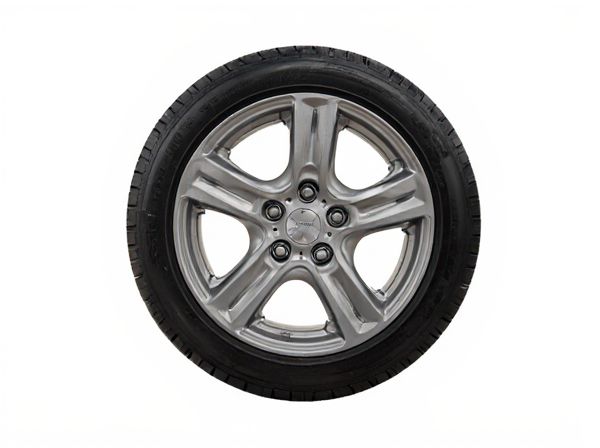
Photo illustration: Hub-centric vs Lug-centric Wheel
Hub-centric wheels align precisely with the hub, ensuring a perfect fit and reducing vibrations, which enhances your vehicle's stability and overall performance. Lug-centric wheels center on the lug nuts, making installation easier but potentially causing imbalance if the hub bore doesn't match the hub diameter accurately. Choosing between these two depends on your need for precision and smooth driving versus convenience and installation speed.
Table of Comparison
| Feature | Hub-centric Wheel | Lug-centric Wheel |
|---|---|---|
| Definition | Wheel centers on the vehicle hub for alignment. | Wheel centers on lug nuts for alignment. |
| Fitment | Precise fit on hub to reduce vibrations. | Relies on lug nuts tension for centering. |
| Safety | Lower risk of wheel wobble and better stability. | Higher chance of misalignment under stress. |
| Installation | Easier and more accurate alignment. | Requires careful lug nut tightening. |
| Common Use | Modern vehicles and performance wheels. | Older vehicles and budget wheels. |
| Cost | Generally higher due to precision engineering. | Lower cost and simpler design. |
Introduction to Hub-Centric and Lug-Centric Wheels
Hub-centric wheels align with the vehicle's hub to ensure precise fitment, minimizing vibrations and improving driving stability by centering the wheel directly on the hub flange. Lug-centric wheels rely on the wheel lugs to center the wheel on the hub, which can lead to minor misalignments and potential vibrations due to less accurate centering. Understanding the difference between these two wheel mounting types is crucial for selecting wheels that enhance safety, performance, and comfort in vehicle operation.
Understanding Wheel Fitment: The Basics
Hub-centric wheels align precisely with the vehicle hub, ensuring a secure and balanced fit that reduces vibration and stress on suspension components. Lug-centric wheels rely on the lug nuts to center the wheel, which can lead to potential imbalance and uneven load distribution if not properly installed. Understanding these differences is crucial for selecting wheels that optimize safety, performance, and tire longevity.
What are Hub-Centric Wheels?
Hub-centric wheels are designed with a center bore that precisely matches the vehicle's hub diameter, ensuring the wheel is perfectly centered on the hub. This design improves wheel alignment, reduces vibrations, and enhances overall driving stability by evenly distributing the vehicle's weight. Hub-centric wheels are commonly preferred for OEM and aftermarket applications due to their superior fit and performance compared to lug-centric wheels.
What are Lug-Centric Wheels?
Lug-centric wheels align precisely with the vehicle's lug nuts, meaning the wheel's fitment depends on the lug studs to center the wheel on the hub. This design contrasts with hub-centric wheels, which rely on the hub's center bore for alignment, reducing vibrations. Lug-centric fitments are common in many vehicles and require proper torque on lug nuts to ensure safe and secure wheel attachment.
Key Differences: Hub-Centric vs Lug-Centric Wheels
Hub-centric wheels center on the vehicle's hub, ensuring precise alignment through a hub ring that fits snugly onto the hub, which reduces vibration and improves stability. Lug-centric wheels, by contrast, rely on lug nuts to center the wheel, using the lug holes to position the wheel rather than the hub, which may cause minor misalignment and potential vibrations. The key difference lies in the centering mechanism: hub-centric wheels offer enhanced ride quality and reduced stress on suspension components, while lug-centric wheels are generally easier to install but can compromise alignment accuracy.
Advantages of Hub-Centric Wheels
Hub-centric wheels offer precise alignment by centering directly on the vehicle hub, reducing vibrations and enhancing overall driving stability. This precise fit improves safety by minimizing stress on suspension components and ensuring even tire wear. Hub-centric designs simplify installation and maintenance, leading to better performance and longer wheel life compared to lug-centric counterparts.
Pros and Cons of Lug-Centric Wheels
Lug-centric wheels offer easy installation and cost-effectiveness by centering the wheel on the lug nuts, reducing reliance on hub precision. However, they may cause alignment issues or vibrations if the hub bore is not properly centered, leading to potential safety concerns and uneven tire wear. While lug-centric designs simplify wheel changes, they generally lack the stability and precision control provided by hub-centric wheels, especially on high-performance or heavy-duty vehicles.
Wheel Selection: Factors to Consider
Wheel selection depends on vehicle type, load capacity, and intended use, with hub-centric wheels offering precise center alignment on the hub for enhanced stability and vibration reduction. Lug-centric wheels rely on lug nuts to center the wheel, making them more common in aftermarket applications but potentially less stable under heavy loads. Factors to consider include hub bore size compatibility, vehicle weight distribution, and the need for consistent wheel balancing to ensure optimal performance and safety.
Common Problems and Solutions
Hub-centric wheels often face issues like uneven weight distribution causing vibrations and premature bearing wear, while lug-centric wheels may suffer from improper fit leading to wheel misalignment and lug nut loosening. Common solutions for hub-centric problems include using hub-centric rings to ensure precise alignment and reduce vibrations, whereas for lug-centric wheels, proper torque application and regular lug nut inspections prevent loosening and maintain secure mounting. Both wheel types benefit from routine maintenance and using manufacturer-recommended components to enhance safety and performance.
Which is Better: Hub-Centric or Lug-Centric?
Hub-centric wheels provide a precise fit by centering directly on the vehicle's hub, reducing vibrations and improving stability. Lug-centric wheels rely on the lug nuts to center the wheel, which can sometimes cause misalignment and uneven wear. Hub-centric wheels are generally better for performance and safety due to their enhanced alignment and load distribution.
 caratoz.com
caratoz.com